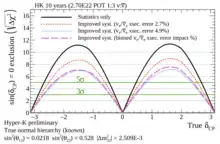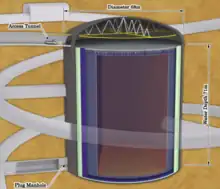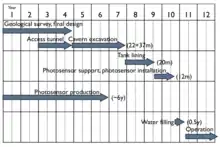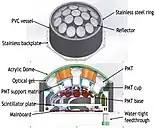Hyper-Kamiokande
Hyper-Kamiokande (also called Hyper-K or HK) is a neutrino observatory and experiment under construction, conducted in Japan by the collaboration of institutes from 21 countries (as of August 2023) from six continents.[1] As a successor of the Super-Kamiokande (SK) and T2K experiments, it is designed to search for proton decay and detect neutrinos from natural sources such as the Earth, the atmosphere, the Sun and the cosmos, as well as to study neutrino oscillations of the man-made accelerator neutrino beam.[2]: 6, 20–28 The beginning of data-taking is planned for 2027.[3]

The Hyper-Kamiokande experiment facility will be located in two places:
- The neutrino beam will be produced in the accelerator complex J-PARC and studied by the set of near and intermediate detectors located in Tokai village, Ibaraki prefecture, on the east coast of Japan.[2]: 31
- The main detector, also called Hyper-Kamiokande (HK), is being constructed under the peak of Nijuugo Mountain in Hida city, Gifu Prefecture, in the Japanese Alps. The HK detector will be used for proton decay searches, studies of neutrinos from natural sources and will serve as a far detector for the measurement of the oscillations of an accelerator neutrino beam at the distance corresponding to the first oscillation maximum.[2]: 53–56 [4]
Physics
Accelerator and atmospheric neutrino oscillations
Neutrino oscillations are a quantum mechanical phenomenon in which neutrinos change their flavour (neutrino flavours states:
ν
e,
ν
μ,
ν
τ) while moving, caused by the fact that the neutrino flavour states are a mixture of the neutrino mass states (ν1, ν2, ν3 mass states with masses m1, m2, m3, respectively). The oscillation probabilities depend on the six theoretical parameters: three mixing angles (θ12, θ23 and θ13) governing the mixing between mass and flavour states, two mass square differences (∆m212 and ∆m232, where ∆m2ij = m2i - m2j) and δCP phase responsible for the matter-antimatter asymmetry in the neutrino oscillations.[5]: 285–311 [2]: 20–23
Continuing studies done by the T2K experiment, the HK detector will measure the energy spectra of electron and muon neutrinos in the beam produced at J-PARC as almost pure muon neutrino beam and compare it with the beam composition measured by the near and intermediate detectors. For the T2K/HK neutrino beam mean energy, the J-PARC - HK detector distance corresponds to the first oscillation maximum. The measurements will be done separately for the neutrino and antineutrino beams, providing information about P
ν
μ →
ν
e, P
ν
μ →
ν
μ, P
ν
μ →
ν
e, P
ν
μ →
ν
μ, where Pνα → Pνβ is the probability that a neutrino originally of flavour α will be observed later as having flavour β.[2]: 202–224

Comparison of the appearance probabilities for neutrinos and antineutrinos(P
ν
μ →
ν
e versus P
ν
μ →
ν
e) allows to measure δCP phase. δCP ranges from -π to π (from −180° to 180°), and 0 and ±π correspond to the CP symmetry conservation. After 10 years of data taking, HK is expected to confirm at the 5σ confidence level if CP symmetry is violated in the neutrino oscillations for 57% of possible δCP values.[2] The CP violation is one of the conditions necessary to produce the excess of matter over antimatter at the early universe, which forms now our matter-built Universe. Accelerator neutrinos will be used to enhance also the precision of the other oscillation parameters, |∆m232|, θ23 and θ13, as well as for the neutrino interaction studies.[2]: 202–224
The unknown sign of the ∆m232 parameter manifests itself only during the neutrino propagation in matter. The HK experiment studies of the atmospheric neutrinos travelling through the Earth and entering the HK detector from different directions (the baseline in the matter up to the Earth's diameter) will be used to measure it.[2]: 225–237
Neutrino Astronomy and Geoneutrinos
Supernova explosions produce great quantities of neutrinos. For a galactic supernova at a distance of 10 kpc about 50000 to 94000 neutrino interactions are expected in the HK detector during a few tens of seconds. For Betelgeuse at the distance 0.2 kpc, this rate could reach up to 108 interactions per second and such a number of events was taken into account during the design of the detector DAQ system. Time profiles of the number of events registered in HK and their mean energy would enable testing models of the explosion. Neutrino directional information in the HK detector can provide an early warning for the electromagnetic supernova observation, as well as can be used in other multi-messenger observations.[6][2]: 263–280
Neutrinos cumulatively produced by supernova explosions throughout the history of the universe are called supernova relic neutrinos (SRN) or diffuse supernova neutrino background (DSNB) and they carry information about star formation history. Because of low flux (few tens/cm2/sec.), they are not discovered yet. For ten years of data taking, HK is expected to detect about 70 SRN events for the energy range 16-30 MeV.[2]: 276–280 [7]
For the solar
ν
e's, the HK experiment goals are i.a.:
- Search for day-night asymmetry in the neutrino flux - resulting from different distances travelled in matter (during the night neutrinos cross the Earth before entering the detector) and thus the different oscillation probabilities caused by the matter effect.[2]: 238–244
- Measurement of the
ν
e survival probability for neutrino energies between 2 and 7 MeV - i.e. between regions dominated by oscillations in vacuum and oscillations in matter, respectively - which is sensitive to new physics models, like sterile neutrinos or non-standard interactions.[2]: 238–244 [8] - The first observation of neutrinos from the hep channel: predicted by the Standard Solar Model.[2]: 238–244
- Comparison of the neutrino flux with the solar activity (e.g. the 11-year solar cycle).[9]
Geoneutrinos are produced in decays of radionuclides inside the Earth. Hyper-Kamiokande geoneutrino studies will help assess the Earth's core chemical composition, which is connected with the generation of the geomagnetic field.[2]: 292–293
Proton Decay
The decay of a free proton into lighter subatomic particles has never been observed, but it is predicted by some grand unified theories (GUT) and was first proposed to explain the predominance of matter over antimatter in the universe. The main channels studied by HK are
p+
→
e+
+
π0
and
p+
→
ν
+
K+
, which are favoured by many GUT models. After ten years of data taking, HK is expected to increase the lower limit of the proton mean lifetime from 1.6x1034 to 6.3x1034 for its most sensitive decay channel (
p+
→
e+
+
π0
) and from 0.7x1034 to 2.0x1034 for another decay channel (
p+
→
ν
+
K+
).[2]: 26–28, 245–257
Dark Matter
Dark matter is a hypothetical, non-luminous form of matter proposed to explain numerous astronomical observations suggesting the existence of additional invisible mass in galaxies. If the dark matter particles interact weakly, they may produce neutrinos through annihilation or decay. Those neutrinos could be visible in the HK detector as an excess of neutrinos from the direction of large gravitational potentials such as the galactic centre, the Sun or the Earth, over an isotropic atmospheric neutrino background.[2]: 281–286
Experiment Description
The Hyper-Kamiokande experiment consists of an accelerator neutrino beam, a set of near detectors, the intermediate detector and the far detector (also called Hyper-Kamiokande). The far detector by itself will be used for proton decay searches and studies of neutrinos from natural sources. While all the above elements will serve for the accelerator neutrino oscillation studies. Before launching the HK experiment, the T2K experiment will finish data taking and HK will take over its neutrino beamline and set of near detectors, while the intermediate and the far detectors have to be constructed anew.[10]
Neutrino Beamline
Near Detectors
Intermediate Detector
The Intermediate Water Cherenkov Detector (IWCD) will be located at a distance of 0.7–2.0 kilometres (0.43–1.24 mi) from the neutrino production place. It would be a cylinder filled with water of 10 metres (33 ft) diameter and 50 metres (160 ft) height with a 10 metres (33 ft) tall structure instrumented with around 3000 photomultiplier tubes of a 20 centimetres (7.9 in) diameter. The structure will be moved in a vertical direction by a crane system, providing measurements of neutrino interactions at different off-axis angles, spanning from 1° at the bottom to 4° at the top, and thus for different energy spectra. Combining the results from different off-axis angles it is possible to extract the results for nearly monochromatic neutrino spectrum without relying on theoretical models of neutrino interactions to reconstruct neutrino energy. Usage of the same type of detector as the far detector with almost the same angular and momentum acceptance allows comparing results from these two detectors without relying on detectors response simulations. These two facts, independence from the neutrino interaction and detector response models, will enable to minimise systematic error in the oscillation analysis. Additional advantages of such a design of the detector is a possibility to search for sterile oscillation pattern for different off-axis angles and to obtain a cleaner sample of electron neutrino interaction, whose fraction is larger for the larger off-axis angle.[2]: 47–50 [11][12]
Hyper-Kamiokande Far Detector

The Hyper-Kamiokande detector will be located 8 kilometres (5.0 mi) south from the Super-Kamiokande (SK) detector in the Tochibora mine, 650 metres (2,130 ft) under the peak of Nijuugo Mountain, at the same off-axis angle (2.5°) to the neutrino beam centre and at the same distance (295 kilometres (183 mi)) from the beam production place as SK.
HK will be a water Cherenkov detector, 5 times larger (258 kton of water) than the SK detector. It will be a cylindrical tank of 74 metres (243 ft) diameter and 60 metres (200 ft) height. The tank volume will be divided into the Inner Detector (ID) and the Outer Detector (OD) by a 60 cm-wide inactive cylindrical structure, with its outer edge positioned 1 meter away from vertical and 2 meters away from horizontal tank walls. The structure will optically separate ID from OD and will hold PhotoMultiplier Tubes (PMT) looking both inwards to the ID and outwards to the OD. For ID, there will be up to 40000 of 50 centimetres (20 in) diameter PhotoMultiplier Tubes (PMT) of type R12860 by Hamamatsu Photonics and approximately 1000 multi-PMT modules (mPMTs). Each mPMT module consists of nineteen 3-inch diameter photomultiplier tubes encapsulated in a water-proof vessel. The OD will be instrumented with up to 8000 7.6 centimetres (3.0 in) PMTs and will serve as a veto[note 1] to distinguish interactions occurring inside from particles entering from the outside of the detector (mainly cosmic-ray muons).[13][14]

The HK detector construction began in 2020 and the start of data collection is expected in 2027.[10]: 24 [2][3] It is also considered to build a second, identical water-Cherenkov tank in Korea around 1100 km from J-PARC, which would be operational 6 years after the first tank.[4]
History and schedule

- September 1999: First ideas presented[15]
- 2000: Name “Hyper-Kamiokande” first used[16]
- September 2011: Submitting LOI[17]
- January 2015: MoU for cooperation in the Hyper-Kamiokande project signed by two host institutions: ICR and KEK. Formation of the Hyper-Kamiokande proto-collaboration[18][19]
- May 2018: Hyper-Kamiokande Design Report[2]
- September 2018: Seed funding from MEXT allocated in 2019[20]
- February 2020: Project officially approved by Japanese Diet[3]
- May 2021: Start of the access tunnel excavation[21]
- 2021: Beginning of the photomultiplier tubes mass production[22]
- February 2022: Completion of the access tunnel construction[23]
- October 2023: Completion of the main cavern dome section[24]
- 2027: The expected beginning of data-taking[3]
Notes
- Veto is part of a detector where no activity should be registered to accept an event. Such requirement allows constraining the number of background events in a selected sample.
Bibliography
- Di Lodovico, Francesca (2017). "The Hyper-Kamiokande Experiment". Journal of Physics: Conference Series. 888 (1): 012020. Bibcode:2017JPhCS.888a2020D. doi:10.1088/1742-6596/888/1/012020.
- Normile, D (2015). "Particle physics. Japanese neutrino physicists think really big". Science. 347 (6222): 598. doi:10.1126/science.347.6222.598. PMID 25657225.
References
- "Hyper-Kamiokande website: Collaboration Institutes".
- Hyper-Kamiokande Proto-Collaboration (28 November 2018). "Hyper-Kamiokande Design Report". arXiv:1805.04163 [physics.ins-det].
- "The Hyper-Kamiokande project is officially approved". Kamioka Observatory ICRR, The University of Tokyo. 12 February 2018.
- Francesca Di Lodovico (Queen Mary, U. of London) for the Hyper-Kamiokande collaboration (Sep 20, 2017). "The Hyper-Kamiokande Experiment". J. Phys. Conf. Ser. 888 (1): 012020. doi:10.1088/1742-6596/888/1/012020.
- Particle Data Group and Workman (August 2022). "Review of Particle Physics". Progress of Theoretical and Experimental Physics. 2022 (8): 083C01. doi:10.1093/ptep/ptac097.
- the Hyper-Kamiokande collaboration (Jan 13, 2021). "Supernova Model Discrimination with Hyper-Kamiokande". Astrophys. J. 916 (1): 15. arXiv:2101.05269. doi:10.3847/1538-4357/abf7c4.
- Yano, Takatomi (2021). "Prospects for neutrino astrophysics with Hyper-Kamiokande". PoS. ICRC2021: 1193. doi:10.22323/1.395.1193.
- Maltoni, Michele and Smirnov, Alexei Yu. (Jul 19, 2015). "Solar neutrinos and neutrino physics". Eur. Phys. J. A. 52 (4): 87. arXiv:1507.05287. doi:10.1140/epja/i2016-16087-0.
{{cite journal}}: CS1 maint: multiple names: authors list (link) - "Hyper-Kamiokande website: Cosmic Neutrino Observation: Solar neutrinos".
- Vilela, Cristovao (September 5–10, 2021). "The status of T2K and Hyper-Kamiokande experiments". PANIC 2021 Conference. Archived from the original on 2021-09-29. Retrieved 2021-09-29.
- nuPRISM Collaboration (13 December 2014). "Letter of Intent to Construct a nuPRISM Detector in the J-PARC Neutrino Beamline". arXiv:1412.3086 [physics.ins-det].
- nuPRISM Collaboration (7 July 2016). "Proposal for the NuPRISM Experiment in the J-PARC Neutrino Beamline" (PDF). Archived (PDF) from the original on 2 December 2020. Retrieved 1 April 2020.
- Jan Kisiel (Silesia U.) for the Hyper-Kamiokande collaboration (Jun 28, 2023). "Photodetection and electronic system for the Hyper-Kamiokande Water Cherenkov detectors". Nucl. Instrum. Meth. A. 1055: 168482. doi:10.1016/j.nima.2023.168482.
- "Hyper-Kamiokande website: Hyper-Kamiokande Detector".
- Shiozawa, M. (23–25 September 1999). "Study of 1-Megaton water Cherenkov detectors for the future proton decay search". AIP Conf.Proc. 533 (2000) 1, 21-24. International Workshop on Next Generation Nucleon Decay and Neutrino Detector (NNN99). Stony Brook, NY, United States. doi:10.1063/1.1361719.
{{cite conference}}: CS1 maint: date format (link) - Nakamura, K. (2000). "HYPER-KAMIOKANDE: A next generation water Cherenkov detector for a nucleon decay experiment". Part of Neutrino oscillations and their origin. Proceedings, 1st Workshop, Fujiyoshida, Japan, February 11-13: 359–363.
- K. Abe; et al. (15 September 2011). "Letter of Intent: The Hyper-Kamiokande Experiment --- Detector Design and Physics Potential ---". arXiv:1109.3262 [hep-ex].
- "Hyper-Kamiokande website: The Inaugural Symposium of the Hyper-K Proto-Collaboration". Kashiwa, Japan. February 5, 2015.
- "Proto-collaboration formed to promote Hyper-Kamiokande". CERN Courier. 9 April 2015.
- "Hyper-Kamiokande construction to start in 2020". CERN Courier. 28 September 2018.
- "Groundbreaking ceremony for Hyper-Kamiokande held in Hida, Japan". The University of Tokyo. 28 May 2021.
- Itow, on behalf of the Hyper-Kamiokande Collaboration, Y. (2021). "Construction status and prospects of the Hyper-Kamiokande project". POS Volume 395 - 37th International Cosmic Ray Conference (ICRC2021). Proceedings of Science: 1192. doi:10.22323/1.395.1192. S2CID 199687331.
- "The excavation of the access tunnel has been completed". Hyper-Kamiokande--latest news. Retrieved 14 April 2022.
- "Hyper-Kamiokande website: Completion of the main cavern dome section of the Hyper-Kamiokande experiment". 11 October 2023.



